In Naungcho Township, Shan State (North), basic education schools that were closed for nearly a year due to terrorist activities are rapidly reopening. Student admissions began on July 22 to facilitate immediate learning.
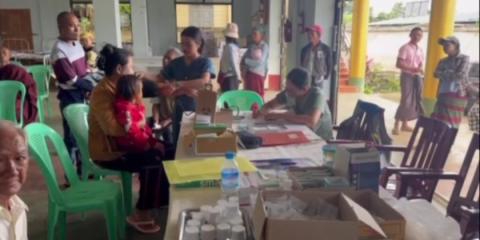
In Naungcho Township, Shan State (North), basic education schools that were closed for nearly a year due to terrorist activities are rapidly reopening. Student admissions began on July 22 to facilitate immediate learning.
Today on July 26, Basic Education High School No. 1 in Naungcho officially reopened, with 857 students beginning their studies. To ensure a peaceful, happy, clean, and safe learning environment for the students, Tatmadaw personnel have carried out necessary mine clearance, security, and school perimeter cleaning operations.
Additionally, doctors served in Tatmadaw, in collaboration with doctors and healthcare workers from the Ministry of Health, have opened a temporary hospital at the Myanan Tawwin Mingalar Hall to provide seamless healthcare services for the local ethnic population.
On July 26, 145 local ethnic people have received healthcare services. Furthermore, departmental staff have worked to ensure the timely reopening of the Public Hospital in Naungcho. Their efforts included clearing bushes and weeds around the hospital, digging and dredging drains to improve water flow, and conducting general cleaning.
mitv
In Naungcho Township, Shan State (North), basic education schools that were closed for nearly a year due to terrorist activities are rapidly reopening. Student admissions began on July 22 to facilitate immediate learning.
Today on July 26, Basic Education High School No. 1 in Naungcho officially reopened, with 857 students beginning their studies. To ensure a peaceful, happy, clean, and safe learning environment for the students, Tatmadaw personnel have carried out necessary mine clearance, security, and school perimeter cleaning operations.
Additionally, doctors served in Tatmadaw, in collaboration with doctors and healthcare workers from the Ministry of Health, have opened a temporary hospital at the Myanan Tawwin Mingalar Hall to provide seamless healthcare services for the local ethnic population.
On July 26, 145 local ethnic people have received healthcare services. Furthermore, departmental staff have worked to ensure the timely reopening of the Public Hospital in Naungcho. Their efforts included clearing bushes and weeds around the hospital, digging and dredging drains to improve water flow, and conducting general cleaning.
mitv
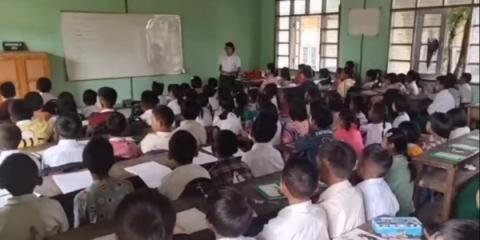
In Naungcho Township, Shan State (North), basic education schools were forced to close for nearly a year due to terrorist activities.
However, today on July 25, Basic Education High School No. 1 has reopened, and students are now receiving lessons. Student admissions are also ongoing.
In Naungcho Township, Shan State (North), basic education schools were forced to close for nearly a year due to terrorist activities.
However, today on July 25, Basic Education High School No. 1 has reopened, and students are now receiving lessons. Student admissions are also ongoing.
The admission period began on July 22, and as of July 25, 705 students have enrolled and are attending classes. To ensure smooth admissions and a peaceful, happy, clean, and safe learning environment for students, Tatmadaw personnel, teachers, education staff, and parents are all collaborating.
Tatmadaw members and departmental officials are jointly undertaking necessary mine clearance, security, and school environment cleanup operations.
Furthermore, to facilitate healthcare services for local ethnic people returning and residing in Naungcho, a temporary hospital has been opened at the Myanan Tawwin Mingalar Hall. Doctors and healthcare workers from the Tatmadaw and the Ministry of Health are jointly providing medical treatment. On 25th July, 147 local ethnic people have received healthcare services.
mitv
In Naungcho Township, Shan State (North), basic education schools were forced to close for nearly a year due to terrorist activities.
However, today on July 25, Basic Education High School No. 1 has reopened, and students are now receiving lessons. Student admissions are also ongoing.
The admission period began on July 22, and as of July 25, 705 students have enrolled and are attending classes. To ensure smooth admissions and a peaceful, happy, clean, and safe learning environment for students, Tatmadaw personnel, teachers, education staff, and parents are all collaborating.
Tatmadaw members and departmental officials are jointly undertaking necessary mine clearance, security, and school environment cleanup operations.
Furthermore, to facilitate healthcare services for local ethnic people returning and residing in Naungcho, a temporary hospital has been opened at the Myanan Tawwin Mingalar Hall. Doctors and healthcare workers from the Tatmadaw and the Ministry of Health are jointly providing medical treatment. On 25th July, 147 local ethnic people have received healthcare services.
mitv
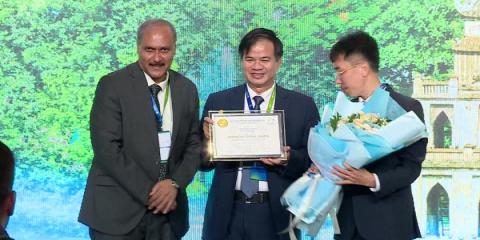
More than 300 doctors and experts in cardiovascular medicine from 15 countries gathered to discuss and share new advancements in stroke treatment.
More than 300 doctors and experts in cardiovascular medicine from 15 countries gathered to discuss and share new advancements in stroke treatment.
During the conference, the World Stroke Organization awarded Bach Mai Hospital the Specialized Stroke Center certification, making it the first hospital in Viet Nam and Southeast Asia to receive this prestigious recognition. Additionally, Associate Professor, Director of the Stroke Center at Bach Mai Hospital, received a dedication award. This marks a significant milestone in standardizing quality stroke treatment in Viet Nam.
mitv
More than 300 doctors and experts in cardiovascular medicine from 15 countries gathered to discuss and share new advancements in stroke treatment.
During the conference, the World Stroke Organization awarded Bach Mai Hospital the Specialized Stroke Center certification, making it the first hospital in Viet Nam and Southeast Asia to receive this prestigious recognition. Additionally, Associate Professor, Director of the Stroke Center at Bach Mai Hospital, received a dedication award. This marks a significant milestone in standardizing quality stroke treatment in Viet Nam.
mitv

Myanmar’s national rowing team will participate in the Dragon Boat Championship at the upcoming World Games, which will be held in Chengdu, China, according to general secretary
U Thet Lwin of the Myanmar Rowing and Canoeing Federation. “We have already selected our athletes since April to represent Myanmar in the Dragon Boat Championship at the World Games in Chengdu, China. The Myanmar rowing team will compete in the 200-metre, 500-metre, and 2,000-metre events,” said U Thet Lwin.
Myanmar’s national rowing team will participate in the Dragon Boat Championship at the upcoming World Games, which will be held in Chengdu, China, according to general secretary
U Thet Lwin of the Myanmar Rowing and Canoeing Federation. “We have already selected our athletes since April to represent Myanmar in the Dragon Boat Championship at the World Games in Chengdu, China. The Myanmar rowing team will compete in the 200-metre, 500-metre, and 2,000-metre events,” said U Thet Lwin.
A 16-member team has been assembled to represent Myanmar in the Dragon Boat events, comprising six male athletes, six female athletes, a team leader, a manager, and two coaches. The team is scheduled to depart for China on 6 August.
The World Games Dragon Boat Championship will be hosted in Chengdu from 6 to 10 August. Only countries that have performed well in qualifying tournaments are eligible to participate.
In addition to this international event, the Myanmar rowing team is also expected to compete in other global competitions in 2025, including the Canoe and Kayak Juniors Championship in Russia. In 2026, they are also set to compete in the Southeast Asian (SEA) Games in Thailand. — ASH/KZL
GNLM
Myanmar’s national rowing team will participate in the Dragon Boat Championship at the upcoming World Games, which will be held in Chengdu, China, according to general secretary
U Thet Lwin of the Myanmar Rowing and Canoeing Federation. “We have already selected our athletes since April to represent Myanmar in the Dragon Boat Championship at the World Games in Chengdu, China. The Myanmar rowing team will compete in the 200-metre, 500-metre, and 2,000-metre events,” said U Thet Lwin.
A 16-member team has been assembled to represent Myanmar in the Dragon Boat events, comprising six male athletes, six female athletes, a team leader, a manager, and two coaches. The team is scheduled to depart for China on 6 August.
The World Games Dragon Boat Championship will be hosted in Chengdu from 6 to 10 August. Only countries that have performed well in qualifying tournaments are eligible to participate.
In addition to this international event, the Myanmar rowing team is also expected to compete in other global competitions in 2025, including the Canoe and Kayak Juniors Championship in Russia. In 2026, they are also set to compete in the Southeast Asian (SEA) Games in Thailand. — ASH/KZL
GNLM

A ceremony to receive Ovada or guidance from the Ovadacariya Sayadawgyis by the Board of Trustees of the Upadasanti Pagoda, for the renovation and restoration of the earthquake-damaged Upadasanti Pagoda and affiliated religious buildings, was held inside the cave hall of the Pagoda in Nay Pyi Taw on July 23rd.
A ceremony to receive Ovada or guidance from the Ovadacariya Sayadawgyis by the Board of Trustees of the Upadasanti Pagoda, for the renovation and restoration of the earthquake-damaged Upadasanti Pagoda and affiliated religious buildings, was held inside the cave hall of the Pagoda in Nay Pyi Taw on July 23rd.
First, the congregation led by the Union Minister for Religious Affairs and Culture received the Five Precepts from the Ovadacariya Sayadawgyi of the Upadasanti Pagoda Board of Trustees, Presiding Sayadaw of the Pauk Myaing Monastery in Lewe Township.
Next, the Union Minister U Tin Oo Lwin supplicated religious affairs explaining that following the powerful Mandalay earthquake on March 28, 2025, significant damage occurred to the Upadasanti Pagoda, the Thathana Maha Beikman, the Visungama Shwe Thein Taw, the Cetiyapala San Kyaung, Sangarama residences (buildings 1 to 4), the Board of Trustees office, and other religious structures.
To address these damages and conduct renovations, various committees were formed under the leadership of the Union Minister and the Chairman of the Nay Pyi Taw Council. These include the Central Renovation Steering Committee, the Operations Committee, the Technical Advisory Subcommittee, the Information and Public Relations Subcommittee, the Finance Subcommittee, the Procurement Subcommittee, and the Security Subcommittee. Coordination meetings have been held, and work is ongoing.
Following that, Nay Pyi Taw Council Chairman U Than Tun Oo also supplicated the religious affairs. Next, Ovadacariya Sayadawgyis of the Upadasanti Pagoda Board of Trustees, led by the Presiding Sayadaw of the Pauk Myaing Monastery in Lewe Township, Bhaddanta Janinda delivered the Ovada Katha.
Then, the Board of Trustees and responsible officials, led by the Union Minister offered donations to the Sayadawgyis. In support of the renovation efforts, Union Minister U Tin Oo Lwin, on behalf of the Ministry of Religious Affairs and Culture and the well-wishers, donated 10.8 million Kyats, which was received by Board of Trustees member U Tun Kyi.
Following that, Nay Pyi Taw Council Chairman U Than Tun Oo donated an additional 10.8 million Kyats on behalf of the Nay Pyi Taw Council, also received by U Tun Kyi.
At the end of the ceremony, the guests led by the Union Minister respectfully listened to a sermon delivered by Ovadacariya Sayadawgyi of the Pagoda Board of Trustees, Presiding Sayadaw of Inn-Tha Ah-Shay monastery in Lewe Township Bhaddanta Pandita, shared the merits gained and concluded the ceremony.
After that, Union Minister U Tin Oo Lwin, Nay Pyi Taw Council Chairman U Than Tun Oo, and officials toured and inspected the earthquake-damaged areas of the cave and precincts of the Upadasnti Pagoda. U Tun Tun, a member of the Nay Pyi Taw Development Committee, gave a briefing on the situation, it was reported.
mitv
A ceremony to receive Ovada or guidance from the Ovadacariya Sayadawgyis by the Board of Trustees of the Upadasanti Pagoda, for the renovation and restoration of the earthquake-damaged Upadasanti Pagoda and affiliated religious buildings, was held inside the cave hall of the Pagoda in Nay Pyi Taw on July 23rd.
First, the congregation led by the Union Minister for Religious Affairs and Culture received the Five Precepts from the Ovadacariya Sayadawgyi of the Upadasanti Pagoda Board of Trustees, Presiding Sayadaw of the Pauk Myaing Monastery in Lewe Township.
Next, the Union Minister U Tin Oo Lwin supplicated religious affairs explaining that following the powerful Mandalay earthquake on March 28, 2025, significant damage occurred to the Upadasanti Pagoda, the Thathana Maha Beikman, the Visungama Shwe Thein Taw, the Cetiyapala San Kyaung, Sangarama residences (buildings 1 to 4), the Board of Trustees office, and other religious structures.
To address these damages and conduct renovations, various committees were formed under the leadership of the Union Minister and the Chairman of the Nay Pyi Taw Council. These include the Central Renovation Steering Committee, the Operations Committee, the Technical Advisory Subcommittee, the Information and Public Relations Subcommittee, the Finance Subcommittee, the Procurement Subcommittee, and the Security Subcommittee. Coordination meetings have been held, and work is ongoing.
Following that, Nay Pyi Taw Council Chairman U Than Tun Oo also supplicated the religious affairs. Next, Ovadacariya Sayadawgyis of the Upadasanti Pagoda Board of Trustees, led by the Presiding Sayadaw of the Pauk Myaing Monastery in Lewe Township, Bhaddanta Janinda delivered the Ovada Katha.
Then, the Board of Trustees and responsible officials, led by the Union Minister offered donations to the Sayadawgyis. In support of the renovation efforts, Union Minister U Tin Oo Lwin, on behalf of the Ministry of Religious Affairs and Culture and the well-wishers, donated 10.8 million Kyats, which was received by Board of Trustees member U Tun Kyi.
Following that, Nay Pyi Taw Council Chairman U Than Tun Oo donated an additional 10.8 million Kyats on behalf of the Nay Pyi Taw Council, also received by U Tun Kyi.
At the end of the ceremony, the guests led by the Union Minister respectfully listened to a sermon delivered by Ovadacariya Sayadawgyi of the Pagoda Board of Trustees, Presiding Sayadaw of Inn-Tha Ah-Shay monastery in Lewe Township Bhaddanta Pandita, shared the merits gained and concluded the ceremony.
After that, Union Minister U Tin Oo Lwin, Nay Pyi Taw Council Chairman U Than Tun Oo, and officials toured and inspected the earthquake-damaged areas of the cave and precincts of the Upadasnti Pagoda. U Tun Tun, a member of the Nay Pyi Taw Development Committee, gave a briefing on the situation, it was reported.
mitv
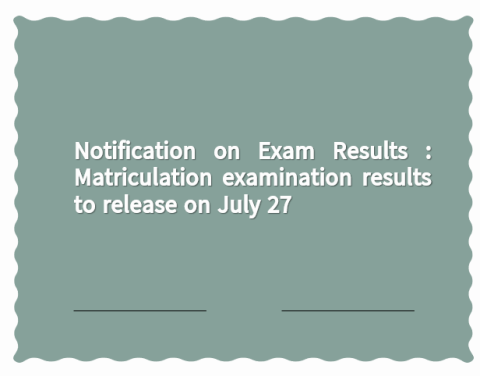
The Ministry of the Education issued a notification on the release of 2025 matriculation examination results. In the notification, it’s described that the results of the 2025 Matriculation Examination will be released and announced on Sunday, July 27, 2025, at 6:00 AM.
The Ministry of the Education issued a notification on the release of 2025 matriculation examination results. In the notification, it’s described that the results of the 2025 Matriculation Examination will be released and announced on Sunday, July 27, 2025, at 6:00 AM.
These results will be posted simultaneously at the examination center schools in their respective townships. The results will also be made available for viewing on the Myanmar Examination Department's official website, www.myanmarexam.org, starting at 4:00 AM on July 27, 2025, the day of the results release.
In addition to the website announcement, for examination centers in remote areas or those with poor internet connectivity, the matriculation examination results will also be announced via the Myanmar Radio program on the day of the results release.
All are kindly requested to cooperate by strictly adhering to the COVID-19 prevention and control regulations issued by the Ministry of Health when visiting the respective examination centers to view the results. If there are any unclear matters regarding the results, anyone can contact the Myanmar Examination Department at phone number (01-653509) on Sunday, July 27, 2025, the day the results are announced.
mitv
The Ministry of the Education issued a notification on the release of 2025 matriculation examination results. In the notification, it’s described that the results of the 2025 Matriculation Examination will be released and announced on Sunday, July 27, 2025, at 6:00 AM.
These results will be posted simultaneously at the examination center schools in their respective townships. The results will also be made available for viewing on the Myanmar Examination Department's official website, www.myanmarexam.org, starting at 4:00 AM on July 27, 2025, the day of the results release.
In addition to the website announcement, for examination centers in remote areas or those with poor internet connectivity, the matriculation examination results will also be announced via the Myanmar Radio program on the day of the results release.
All are kindly requested to cooperate by strictly adhering to the COVID-19 prevention and control regulations issued by the Ministry of Health when visiting the respective examination centers to view the results. If there are any unclear matters regarding the results, anyone can contact the Myanmar Examination Department at phone number (01-653509) on Sunday, July 27, 2025, the day the results are announced.
mitv
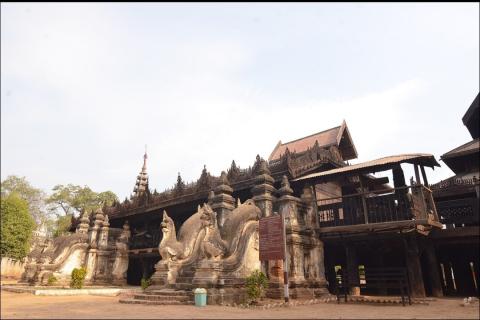
Monasteries with significant masterpieces of wood carvings, illustrating 550 Jataka stories and Dhammapada verses and stories, are called Yokesone monasteries.
There are many ancient Yokesone monasteries in Myanmar. Of them, Mandalay Shweinpin Yokesone Monastery, Sagaing Yokesone Monastery, Salin Yokesone Monastery and Panpu Yokesone Monastery in Salay and Sagu’s three-storey Yokesone Monastery, Hmankin Yokesone Monastery in Minbu (Sagu) Township and Lekaing Monastery located between Sagu and Pwintbyu are the most famous places.
Monasteries with significant masterpieces of wood carvings, illustrating 550 Jataka stories and Dhammapada verses and stories, are called Yokesone monasteries.
There are many ancient Yokesone monasteries in Myanmar. Of them, Mandalay Shweinpin Yokesone Monastery, Sagaing Yokesone Monastery, Salin Yokesone Monastery and Panpu Yokesone Monastery in Salay and Sagu’s three-storey Yokesone Monastery, Hmankin Yokesone Monastery in Minbu (Sagu) Township and Lekaing Monastery located between Sagu and Pwintbyu are the most famous places.
Some Yokesone monasteries have been preserved and carefully restored by the Department of Archaeology and National Museum, maintaining the original structure. The visitors can observe intricate wood carvings depicting the tales, and its exterior is adorned with detailed carvings.
Yokesone monasteries are cultural hubs and architectural landmarks with symbolism. Monasteries representing cultural fusion of late Konbaung Dynasty, Inwa, Amarapura and Yadanabon eras. Those ancient monasteries are preserved through generations for historical and architectural significance. Those magnificently decorated sculptural monasteries are preserved for future generations to showcase Myanmar’s exquisite artistic heritage to homegrown visitors and tourists. – Zayar Naing (Shwekanmyay)/KK
GNLM
Monasteries with significant masterpieces of wood carvings, illustrating 550 Jataka stories and Dhammapada verses and stories, are called Yokesone monasteries.
There are many ancient Yokesone monasteries in Myanmar. Of them, Mandalay Shweinpin Yokesone Monastery, Sagaing Yokesone Monastery, Salin Yokesone Monastery and Panpu Yokesone Monastery in Salay and Sagu’s three-storey Yokesone Monastery, Hmankin Yokesone Monastery in Minbu (Sagu) Township and Lekaing Monastery located between Sagu and Pwintbyu are the most famous places.
Some Yokesone monasteries have been preserved and carefully restored by the Department of Archaeology and National Museum, maintaining the original structure. The visitors can observe intricate wood carvings depicting the tales, and its exterior is adorned with detailed carvings.
Yokesone monasteries are cultural hubs and architectural landmarks with symbolism. Monasteries representing cultural fusion of late Konbaung Dynasty, Inwa, Amarapura and Yadanabon eras. Those ancient monasteries are preserved through generations for historical and architectural significance. Those magnificently decorated sculptural monasteries are preserved for future generations to showcase Myanmar’s exquisite artistic heritage to homegrown visitors and tourists. – Zayar Naing (Shwekanmyay)/KK
GNLM
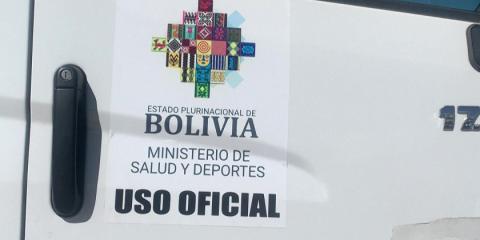
Bolivia on Monday received a shipment of 300,000 doses of vaccines against measles and rubella donated by India in response to an outbreak throughout the country.
Previously, Bolivia has received 600,000 doses from Brazil and 100,000 doses from Venezuela. The Bolivian government declared a national health emergency on June 24th , after confirming an increase in measles cases over the previous two months.
mitv
Bolivia on Monday received a shipment of 300,000 doses of vaccines against measles and rubella donated by India in response to an outbreak throughout the country.
Previously, Bolivia has received 600,000 doses from Brazil and 100,000 doses from Venezuela. The Bolivian government declared a national health emergency on June 24th , after confirming an increase in measles cases over the previous two months.
mitv
Bolivia on Monday received a shipment of 300,000 doses of vaccines against measles and rubella donated by India in response to an outbreak throughout the country.
Previously, Bolivia has received 600,000 doses from Brazil and 100,000 doses from Venezuela. The Bolivian government declared a national health emergency on June 24th , after confirming an increase in measles cases over the previous two months.
mitv
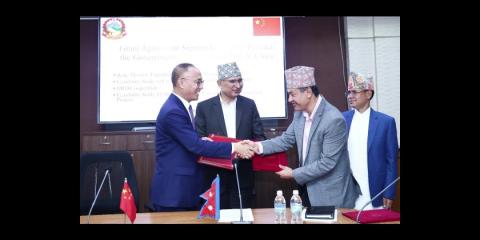
Nepal Deputy Prime Minister and Finance Minister Bishnu Prasad Poudel hold a meeting with China International Development Cooperation Agency (CIDCA) Chairman Chen Xiaodong to discuss Nepal-China bilateral relations and development cooperation.
Nepal Deputy Prime Minister and Finance Minister Bishnu Prasad Poudel hold a meeting with China International Development Cooperation Agency (CIDCA) Chairman Chen Xiaodong to discuss Nepal-China bilateral relations and development cooperation.
The meeting at the Ministry of Finance focused on ongoing and future projects supported by Chinese assistance. Four memorandums of understanding were signed, including one for a bone marrow transplant facility at BP Koirala Memorial Cancer Hospital and another for a feasibility study on expanding the civil servant hospital.
Agreements were also made on human resource development and a feasibility study for the Rasuwagadhi-Kerung cross-border electricity transmission line.
mitv
Nepal Deputy Prime Minister and Finance Minister Bishnu Prasad Poudel hold a meeting with China International Development Cooperation Agency (CIDCA) Chairman Chen Xiaodong to discuss Nepal-China bilateral relations and development cooperation.
The meeting at the Ministry of Finance focused on ongoing and future projects supported by Chinese assistance. Four memorandums of understanding were signed, including one for a bone marrow transplant facility at BP Koirala Memorial Cancer Hospital and another for a feasibility study on expanding the civil servant hospital.
Agreements were also made on human resource development and a feasibility study for the Rasuwagadhi-Kerung cross-border electricity transmission line.
mitv

Surfing enthusiasts have cheered the reopening of a beloved whitewater site in downtown Munich. After a safety review and a petition to keep it open, the site was reopened by authorities in recent weeks. Nearby, surfers performed tricks with virtuosity on the powerful wave, formed by the presence of rocks on the riverbed near a bridge.
Surfing enthusiasts have cheered the reopening of a beloved whitewater site in downtown Munich. After a safety review and a petition to keep it open, the site was reopened by authorities in recent weeks. Nearby, surfers performed tricks with virtuosity on the powerful wave, formed by the presence of rocks on the riverbed near a bridge.
The head of local surfers' association said there are between three and five thousand surfers actively practicing the sport here. And surfing is simply part of the Munich lifestyle. Not just for the surfers themselves, but also for the cityscape.
mitv
Surfing enthusiasts have cheered the reopening of a beloved whitewater site in downtown Munich. After a safety review and a petition to keep it open, the site was reopened by authorities in recent weeks. Nearby, surfers performed tricks with virtuosity on the powerful wave, formed by the presence of rocks on the riverbed near a bridge.
The head of local surfers' association said there are between three and five thousand surfers actively practicing the sport here. And surfing is simply part of the Munich lifestyle. Not just for the surfers themselves, but also for the cityscape.
mitv

